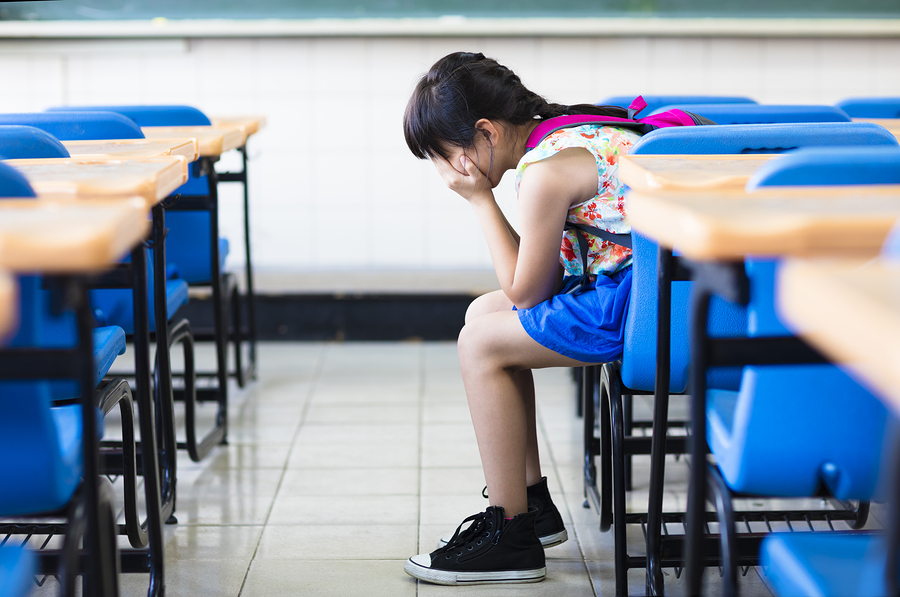
Know the Signs and Severity

Know the Signs and Severity
The National Association of School Psychologists (NASP) defines anxiety as “apprehension or excessive fear about real or imagined circumstances.” Every child experiences some anxiety, especially in certain situations — such as during the first week(s) of school or before a big test or class presentation. But when worry becomes excessive beyond expectations — or to the point where it affects her social, personal, and academic life — an anxiety disorder may be the cause. Watch for signs, such as refusal to go to school or do homework, panic attacks, obsessive behavior, stomachaches, headaches, or trouble sleeping. Although you might associate anxiety more with teens and young adults, experts say that anxiety disorder symptoms typically emerge by age 6. Read up on signs and symptoms of childhood anxiety disorders and talk with your child’s pediatrician to get a proper diagnosis and treatment plan if professional help is needed.
Talk with the Teacher

Talk with the Teacher
Send a note to your child’s teacher early in the school year asking for regular feedback on your child and expressing an interest in a strong parent/teacher partnership. Let her know about test-day jitters or other sources of worry that are affecting your child. The teacher can offer insight on how your child’s anxiety is affecting him at school, and can help you connect with the school psychologist or counselor if needed. If your child has been diagnosed with an anxiety disorder, he has the right under the Individuals with Disabilities Education Act (IDEA) to appropriate accommodations related to his anxiety disorder. Talk with the teacher to arrange accommodations, such as extended time for test-taking or a “cool-down pass” allowing him to leave the classroom for a break if anxiety strikes.
Be Realistic and Accept Mistakes

Be Realistic and Accept Mistakes
Some school-related stress is self-imposed, but Mom and Dad play a big part in piling on the pressure, the American Academy of Pediatrics (AAP) says. Examine your role in your child’s anxiety level, and take a hard look at your expectations: Are they realistic? Don’t expect your struggling student to suddenly score straight A’s junior year, and avoid pushing your child onto the traditional four-year college track if an alternative to college could be a better fit, the AAP says.
“Often, anxious children try to please adults, and will try to be perfect if they think it is expected of them,” the NASP says. Get tips for discussing your child’s grades in a healthy way. It’s especially important for you to remain calm and not to overreact to inevitable bumps in the road early on in the school year so that you can set a positive tone for your child, the NASP says.
Follow Basic Routines

Follow Basic Routines
Most anxious children take comfort in knowing what to expect day to day. So maintaining a consistent — but flexible — routine for homework, chores, and activities can go a long way, the NASP says. If a new school year is about to begin, do a practice run of the first day of school. Trying out the specifics — from bathing and getting dressed to finding good after-school snacks and a quiet place to do homework — will boost your child’s confidence during the first weeks of school. Print out our morning routine, after-school routine, and bedtime routine checklist to help keep your child’s school days predictable. Our printable homework chart and chore chart can also be useful tools.
Find a Balance of Extracurricular Activities

Find a Balance of Extracurricular Activities
Studies have shown that participating in after-school activities may boost kids’ affections for their school, the AAP says. But taking on too many extracurriculars can steal your child’s energy and ability to focus on schoolwork. Keep an eye on your child for signs of irritability, depression, or exhaustion, which can signal that it’s time to give up at least one activity. “Go for quality, not quantity,” the NASP says of extracurricular activities. Also, keep in mind that unstructured playtime and playdates with peers are just as important — if not more so — than organized sports and activities. The NASP recommends arranging at least a few playdates with your child’s classmates early on in the school year to help your child re-establish positive social relationships with peers.
Help Your Child Prepare and Practice

Help Your Child Prepare and Practice
Whether your child is stressing over a big test or presentation on the horizon, or he’s having a series of mini breakdowns related to feeling disorganized, it’s wise of you to step in and help him prepare and practice. The NASP emphasizes that the goal is not “practice makes perfect,” but to help him find tools for making his anxiety more manageable so that he can still function under pressure. Be available to offer guidance during homework time but take a step back and let him do the work himself since you won’t be there to take tests for him. Also, know when certain school subjects (ahem… math?) may not be your strong suit, and consider finding a tutor or getting extra help from the teacher if your own anxiety or distaste for a subject could be rubbing off on your child.
Listen to and Talk with Your Child

Listen to and Talk with Your Child
Show your child that you care — whether it’s by sending notes in her lunchbox or periodically volunteering in her classroom or at school events, or simply by sitting with her for five minutes at the kitchen table to check in every day after school. Keeping in touch with your child’s life and feelings will give her a strong foundation at home and help you notice patterns and red flags. Take stock of whatever is going on in your child’s life, including any family struggles, bullying, friendship problems, ADHD or other learning difficulties, or even issues related to giftedness or shyness. All of these can compound your child’s anxiety. Take heart in knowing that anxiety can be treated, especially when it’s detected early. It’s not realistic (or advisable) to totally eliminate your child’s anxiety, the NASP says, so the goal should be to return your child to a typical level of functioning.





